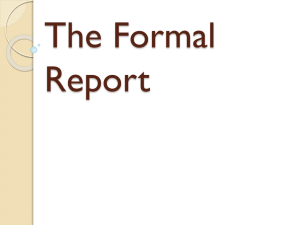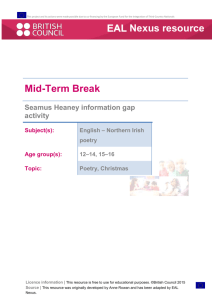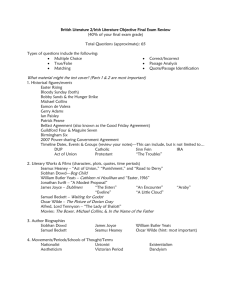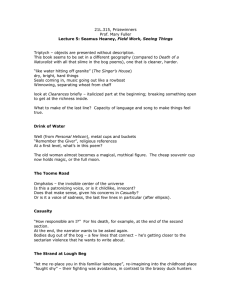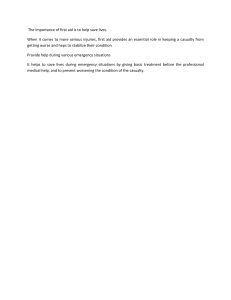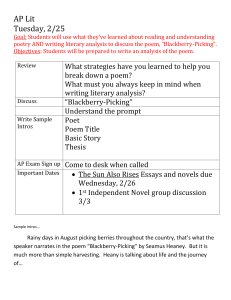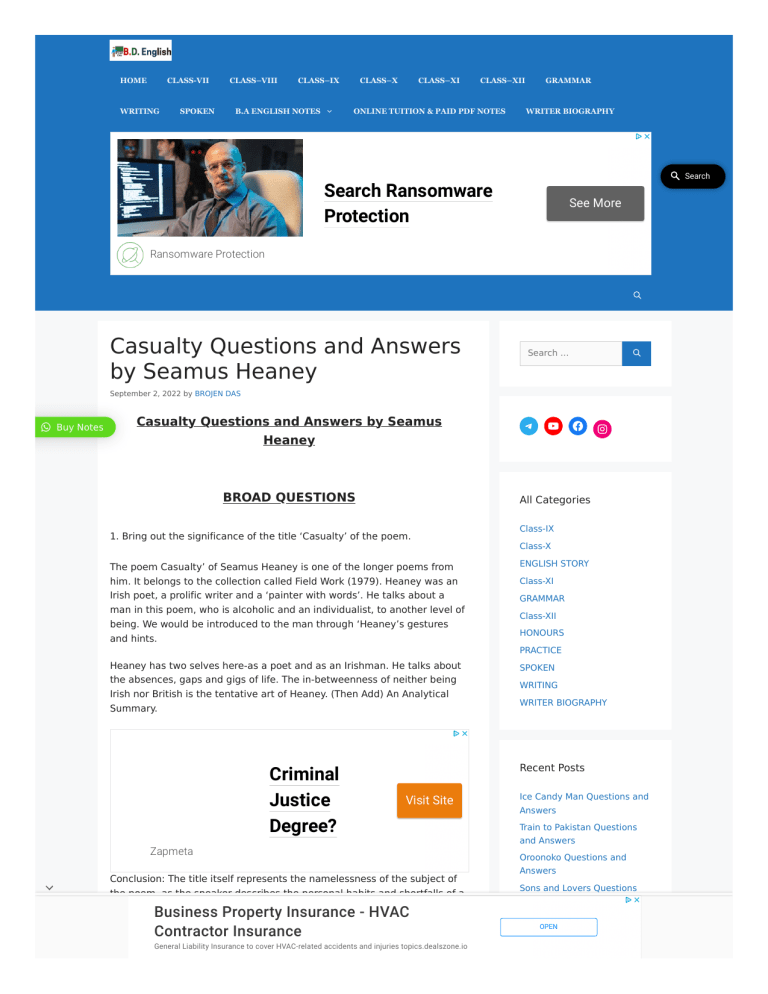
HOME CLASS-VII WRITING SPOKEN CLASS–VIII CLASS–IX B.A ENGLISH NOTES CLASS–X CLASS–XI CLASS–XII ONLINE TUITION & PAID PDF NOTES GRAMMAR WRITER BIOGRAPHY Search Search Ransomware Protection See More Ransomware Protection Casualty Questions and Answers by Seamus Heaney Search … September 2, 2022 by BROJEN DAS Buy Notes Casualty Questions and Answers by Seamus Heaney BROAD QUESTIONS All Categories 1. Bring out the significance of the title ‘Casualty’ of the poem. Class-IX Class-X The poem Casualty’ of Seamus Heaney is one of the longer poems from ENGLISH STORY him. It belongs to the collection called Field Work (1979). Heaney was an Class-XI Irish poet, a prolific writer and a ‘painter with words’. He talks about a GRAMMAR man in this poem, who is alcoholic and an individualist, to another level of being. We would be introduced to the man through ‘Heaney’s gestures and hints. Class-XII HONOURS PRACTICE Heaney has two selves here-as a poet and as an Irishman. He talks about the absences, gaps and gigs of life. The in-betweenness of neither being Irish nor British is the tentative art of Heaney. (Then Add) An Analytical Summary. Criminal Justice Degree? SPOKEN WRITING WRITER BIOGRAPHY Recent Posts Visit Site Zapmeta Conclusion: The title itself represents the namelessness of the subject of the poem, as the speaker describes the personal habits and shortfalls of a man, who was not involved politically. And yet, the fisherman is a victim of Business Property Insurance - HVAC Contractor Bloody Sunday (when the Insurance British Military fired on the Irish people). his own habitual need to have a pint in a pub, but only because of a General Liability Insurance to cover HVAC-related accidents and injuries topics.dealszone.io Ice Candy Man Questions and Answers Train to Pakistan Questions and Answers Oroonoko Questions and Answers Sons and Lovers Questions and Answers Revolving Days Questions OPEN and Answers The poem takes place in 1972, soon after the British paratroopers openly fired on a group of protesters, killing thirteen. Heaney does not chide the subject of the poem because he can relate to the man’s ambivalence toward remaining steadfast in his allegiance to his tribe by only patronising Catholic pubs. Thus, His ‘Casualty’ takes a more complex and realistic approach being the title of the poem. Heaney utilizes the fisherman, a victim of the chaotic ramifications of political terror, in his Subscribe via Email Enter your email address to subscribe Email Address poem in order to set an example of the arbitrary nature of death in the troubles: Subscribe Join 283 other subscribers 2. Critically appreciate Heaney’s poem ‘Casualty’. Or, How Heaney uses his memory-past and present-as an explicate in the Site Details Home poem ‘Casualty’? Discuss. About Us Seamus Heaney’s ‘Casualty’ is an elegy for a fisherman in tender iambic trimeter, that reflects not only the implications of tribal or societal obligations and subsequent political affiliations, but ultimately questions – Is it worth to act on a moral imperative? Contact Us Disclaimer Privacy Policy Terms and Conditions The poem follows the uneventful life of an anonymous and unassuming “dole-kept breadwinner” who, according to the speaker, frequents two very different kinds of “haunts”. The fisherman’s rightful place is on the Buy Notes water, but his other preferred habitation, the pub, is connected by ‘liquid’, although that liquid will be his demise. However, nocturnal drinking will not literally kill the fisherman, but it will cause the fisherman to patronize a bar in an Unionist neighbourhood for the Bloody Sunday curfew, and consequently the Catholic fisherman’s moral ambiguity will result to his death. Search For EMBA degree Open www.dealszone.io Heaney divides ‘Casualty’ into three parts – the first two having three stanzas and the last having only two, with the final being a truncated triplet. As the narrative is shifted back in time, once the speaker mentions the death of the fisherman in a bombing at the end of the first section, the poem’s development seems somewhat confusing or at least non-linear. The rhyme-scheme remains relatively uneven although slipping into ab ab at certain points when Heaney wants to highlight the significance of the passage. The next two sections shift from the funerals for the Bloody Sunday victims and the fisherman’s solitary funeral, to the quiet scene of the speaker going out to fish instead of being at his friend’s funeral. However, the speaker visualizes the man coming back from the dead through the light on the ‘indolent’ waves, and desires for the ghost to ask him again the extent of their duty to their “tribe”. In this connection, a comparison between Yeats and Heaney could be established. Heaney’s ‘Casualty’ is less politically ambitious than Yeats’s ‘The Fisherman’. With its emphasis on questioning and on thought as an experience of difficulty rather than of release – “You’re supposed to be An educated man.” -‘Casualty’ is also less didactic than its Yeatsian predecessor. Nevertheless, Heaney’s poem may be instructively read as a critical companion piece to Yeats’s, particularly in its Yeatsian tendency to seek redemption in nature for what society manifestly disdains to supply. Heaney questions the worth in pursuing a categorical imperative if the end result will so often become extremist. Thus, Heaney departs from Yeats’ romanticized battle against the English through the arbitrary death portrayed in ‘Casualty’. Although styled in a different form, with different stanza lengths, the narrator continued to use rhyme to tell a story. Hence, the storyline of this poem Casualty-is very interesting, albeit the thoughts jumped from section to section and the narrator’s emotion could also be understood Buy Notes clearly and potentially. 3. Can a comparison be made between the two Irish poets – Seamus Heaney and W. B. Yeats? Give references from the poem ‘Casualty’. Or, Describe Heaney’s artistry as a modern Irish poet with references to the text. Establish a comparison with W. B. Yeats, another renowned Irish writer. Students and lovers of Irish poetry will find many intriguing echoes between Seamus Heaney’s ‘Casualty’ and William Butter Yeats’s ‘The Fisherman’: Whereas Yeats makes a strong case for the fisherman as the embodiment of cultural integrity based on personal distinctiveness, Heaney’s lyric is much more quiescent in tone as it befits the personal tenor of this elegy. Heaney can be further alienated from his Irish predecessor, W. B. Yeats, in that the latter poet’s ‘Easter, 1916’, he romanticizes the struggle to oust England from Ireland, while Heaney’s ‘Casualty’ takes a more complex and realistic approach. Heaney’s form in ‘Casualty’ also serves to be antithetical to Yeats’ because it is in the same elegiac trimeter form as ‘Easter, 1916’, but with the infrequent rhyme-scheme, as opposed to Yeats’s conventional rhyming. 2. Critical Appreciation (paragraphs 5 and 6). The speaker of the poem ‘Casualty’ desires to get away from the political violence that was tearing his countrymen apart. At his closing remarks, Heaney makes a sudden shift from speaking of the fisherman in the third person into the second person, so as to bring the subject nearer and show the conjoining of their ambivalence. This three-part poem is highly emotive in the description of the loss of a much-admired companion. Furthermore, through the descriptions, the poet is able to convey his political message-the tension between the Irish Protestants and Catholics can only lead to further pain. 4. Elucidate the poetic structure of ‘Casualty’. Casualty is an elegy written by the Irish poet and writer Seamus Heaney. It is broken up into three distinct sections. The poem has no definite metric or rhyme structure, instead, assonance and rhyme are used only sometimes within the poem in order to emphasize certain lines and phrases, and Heaney also uses parallelism throughout this poem. To Set in Ireland, during the time of the Irish and British troubles, each section of the poem, all of similar length, depicts a different scene narrating the story of a fisherman (presumably Heaney’s friend)-who was killed as a result of the violence arising from the ethno-political conflict between the nationalists (Roman Catholic) and the unionists (mainly Protestants), shortly after Bloody Sunday (also known as ‘Bogside Massacre’) which took place in Derry, Northern Ireland. The title of the poem puts the focus upon the nameless victim, making him the subject within the poem. The deliberate sense of anonymity evoked by the unnamed casualty in the title is reflective of the way such senseless violence affects even the trivial, unidentified, innocent commoners. The people, for example, like the casualty involved in the violence itself. Buy Notes The first section of the poem is written in an intimate tone, full of observations of the speaker’s fisherman friend-his manners and actions as he drinks in a typical Irish pub. Beginning the poem with a pronoun on the opening line of the first stanza He would drink by himself And raise a weathered Thumb Towards the high shelf, Calling another rum And blackcurrant….. – Heaney immediately introduces the subject of the poem-the lone fisherman, whose thumb is weathered from his work, and sets the scene, as he orders a typical drink in the convivial atmosphere and familiar environment of the Irish pub. The first image portrayed in the poem is, however, one of solitude. We can almost see how the coffins would monotonously float one after the other on a sea of people formed by the crowd-“Like blossoms on slow water.” This is creating a solemn feeling that is projected to the audience. The following lines of the stanza convey the confinement of the Irish Catholics under Protestant power. The line “Like brothers in a ring” further emphasizes the point of togetherness like in the word “tightness”. The use of the word “brother” conveys a common link between the people, the link of being of one religion. The use of the word “ring” conveys the image of a confining cage, and also conveys a sense of strength, as if the hardship felt by the Irish Catholics has made them bond together to become stronger. The next stanza of the second section commences with “he would not be held”. This is juxtaposed with “his own crowd” whom, in the face of such horror, had been scared into hiding. Anaphora is used in this poem in lines 16-17 of part II with the repetition of the word “whatever” inWhatever threats were phoned Whatever black flags waved. The pronoun ‘his’ in “Everyone held / His breath and trembled”, as opposed to the general ‘their’, is symbolic of how the whole town-not only the poet-holds the same breath and grieves together in the same way for the victims killed as the result of the senseless and unnecessary violence. The assonance of the hollow vowel sounds (‘cold’, ‘raw’), the adjective ‘raw’ being almost onomatopoeic, evoke the feelings of emptiness, stillness and painful emotion, in direct juxtaposition to the powerful and intense images of the violence in the previous section. In the final stanza, the fisherman’s work is described as a constant rhythm To get out early, haul Buy Notes Steadily off the bottom, dispraise the catch, and smile As you find a rhythm. – It can be felt that the poet had a great admiration for the fisherman’s work. An example of parallelism can be found in lines 2 and 3 of part III with “quiet walkers and sideways talkers”. This phrase also interests one because he or she may expect the adjectives to modify the opposite nouns. The poem concludes with a triplet of lines that reminisce the previous part of the poem: Dawn-sniffing revenant, Plodder through midnight rain, Question me again. The description “Dawn-sniffing” refers to the early leave-wake of a fisherman’s life, out early to get a good catch, sniffing like a dog to search for the fish. “Plodder through midnight rain” refers to the man’s neverending need to quench his alcohol addiction, without car ing for any time or weather. The poem concludes in a highly emotional tone with the line-“Question me again”. Clearly, the poet missed the fisherman’s companionship and presence. This poem seemed to be one of Heaney’s longest poems. ‘Casualty-this three-part poem is highly emotive in the depiction of the loss of a much admired companion. Furthermore, through the descriptions of the situations, the poet is able to convey his political message. VERY SHORT QUESTIONS 1. From where has the poem ‘Casualty’ been taken? Famous Irish poet Seamus Heaney’s phenomenal poem ‘Casualty’ has been taken from the collection Field Work, published in 1979. 2. What is the meaning of the word ‘Casualty’? Who or what is the ‘casualty’ here of which the poet is talking? The word ‘casualty’ means a fatal accident that causes someone to get injured or killed or captured or missing (particularly in a military Buy Notes engagement). Seamus Heaney’s ‘Casualty’ is an elegy for a fisherman that reflects not only on the implications of tribal or societal obligations and subsequent political affiliations, but ultimately questions whether it is worth to act on a moral imperative. 3. What kind of a poem is Heaney’s ‘Casualty’? Seamus Heaney’s ‘Casualty’ is an elegy / a lament for the unknown citizen, an anonymous victim not merely of the social violence of the poet’s native province but also of those tribal attachments that make the violence so difficult. 4. How has Heaney versified the structure of ‘Casualty‘? Heaney divides, the poem ‘Casualty’ into three parts, the first having three stanzas, the last having only two and the final being a truncated triplet. The poem has no definite metric or rhyme structure. 5. Which political views Heaney talks about in the poem? Heaney conveys some political views in the poem ‘Casualty’, very subtly yet effectively, bringing forth the tension between the Irish Catholics and Protestants.. 6. “He would drink by himself.”-Explain. The lines tell mainly about a drinker that the poet knew, but who was killed when the pub he was drinking in, was bombed. The line conveys the sense of loveliness, yet, at the same time, suggests secrecy and the possible participation of the drinker (who is a fisherman) in something that is prohibited. *********************************** Casualty Questions and Answers by Seamus Heaney Casualty Questions and Answers by Seamus Heaney Casualty Questions and Answers by Seamus Heaney Casualty Casualty Casualty Casualty Questions Questions Questions Questions and and and and Answers Answers Answers Answers by by by by Seamus Seamus Seamus Seamus Heaney Heaney Heaney Heaney Casualty Questions and Answers by Seamus Heaney Casualty Questions and Answers by Seamus Heaney Casualty Questions and Answers by Seamus Heaney Casualty Questions and Answers by Seamus Buy Notes Heaney Casualty Questions and Answers by Seamus Heaney Casualty Questions and Answers by Seamus Heaney Casualty Questions and Answers by Seamus Heaney Casualty Questions and Answers by Seamus Heaney Casualty Questions and Answers by Seamus Heaney Casualty Questions and Answers by Seamus Heaney Casualty Questions and Answers by Seamus Heaney Casualty Questions and Answers by Seamus Heaney Casualty Questions and Answers by Seamus Heaney Casualty Questions and Answers by Seamus Heaney Casualty Questions and Answers by Seamus Heaney Casualty Questions and Answers by Seamus Heaney Casualty Questions and Answers by Seamus Heaney Casualty Questions and Answers by Seamus Heaney Casualty Questions and Answers by Seamus Heaney Casualty Questions and Answers by Seamus Heaney Casualty Questions and Answers by Seamus Heaney Casualty Questions and Answers by Seamus Heaney Casualty Questions and Answers by Seamus Heaney Casualty Questions and Answers by Seamus Heaney Casualty Questions and Answers by Seamus Heaney Casualty Questions and Answers by Seamus Heaney Casualty Questions and Answers by Seamus Heaney Casualty Questions and Answers by Seamus Heaney Related Casualty by Seamus Heaney Summary September 2, 2022 In "DSE-T-(1-6)" Digging by Seamus Heaney Summary September 2, 2022 In "DSE-T-(1-6)" DSE-T-(1-6) Leave a Comment Digging Questions and Answers September 2, 2022 In "DSE-T-(1-6)" Name * Email * Website Save my name, email, and website in this browser for the next time I comment. Notify me of follow-up comments by email. Notify me of new posts by email. Post Comment © 2022 - 2023 Brojendasenglish.com Buy Notes About Us Contact Us Disclaimer Privacy Policy Terms and Conditions

